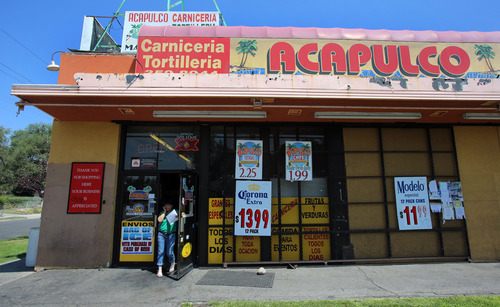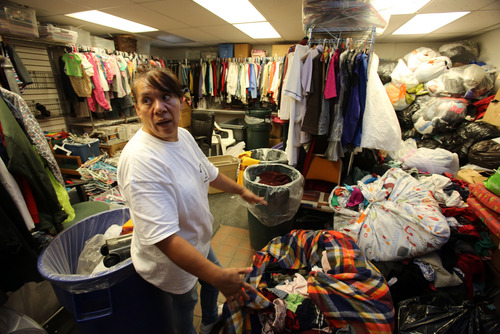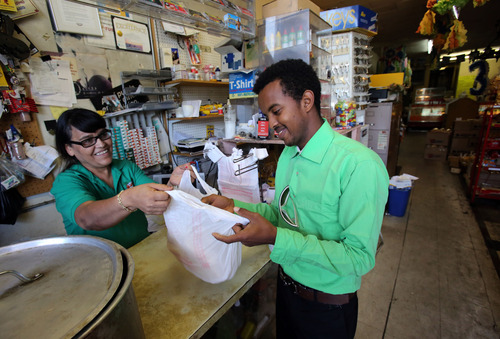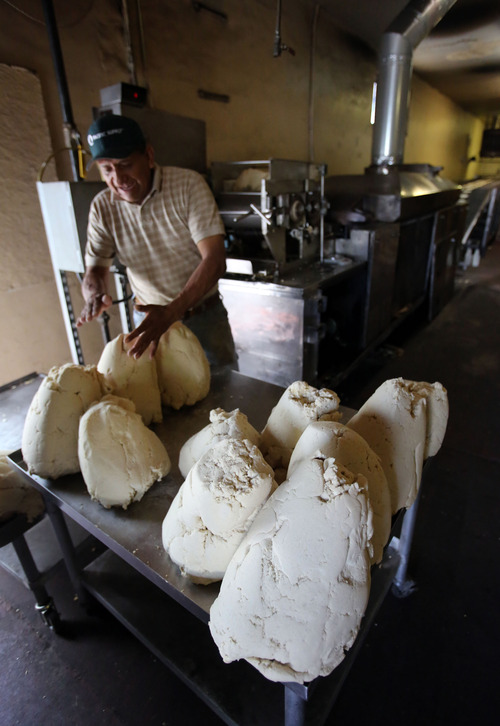This is an archived article that was published on sltrib.com in 2013, and information in the article may be outdated. It is provided only for personal research purposes and may not be reprinted.
This is part of a series of reports giving Tribune readers an insider's view of life in Salt Lake City neighborhoods.
Salt Lake City's Indiana Avenue runs west near 800 South and 900 West to Redwood Road right between Poplar Grove and Glendale — west-side working-class neighborhoods often maligned or just ignored.
The place may appear a little rough on the edges, but there is an undeniable pulse to the community that teems with cultural diversity. It doesn't look like Salt Lake City's east side and some say it shouldn't because it is being shaped by its own cultural influences — with its own special flavor.
Salt Lake City's so-called River District — which includes Glendale and Poplar Grove, as well as the neighborhoods of Fairpark and Rose Park — is a landing pad for immigrants.
Latino immigrants began arriving in the Indiana Avenue area 50 years ago. They were followed by Pacific Islanders. Now, they are among the community stalwarts who are welcoming new Latino immigrants as well as Africans, Asians and eastern Europeans.
—
Majority minorities • "The community is very vibrant," said Archie Archuleta, a Latino community leader who moved into the area in 1960. "When we moved in, the area was about 5 percent minority, mostly Latinos," he said. "Now we have people from Sudan and Ethiopia, Vietnam, Korea and the Pacific islands."
The neighborhoods flanking Indiana Avenue are the most diverse in Utah, according to demographers. Minorities make up about 66 percent of the population, according to 2010 census data as analyzed by the Utah Community Data Project at the University of Utah's Bureau of Economic and Business Research.
Newcomers often arrive with young families or start new ones — and most are not high-wage earners. For some, that means working two or three jobs just to meet basic needs.
About one-third of the population is 17 years old or younger, according to the Community Data Project. Some 90 percent of students at Glendale Middle School qualify for free or subsidized lunch, which means the household income is less than $43,600 for a family of four. Many make much less than that.
Eighteen-year-old Ethiopian Abdul Hashi loves the neighborhood around Indiana Avenue. He also loves the tortillas made fresh at the Acapulco Market run by Mary Hernandez and her son, Rafael Hernandez. Hashi's family uses the Mexican mainstay to create sambusas, a traditional Ethiopian dish.
Hashi came to Salt Lake City two years ago with his mother and father and five brothers and sisters. He is a senior at East High School and hopes to attend community college next year.
"I like it here," he said. "It's a better life and I am getting a better education."
—
The neighborhood's backbone • New immigrants face many challenges, cultural and economic, explained K.C. Owens, manager of the Crossroads Urban Center Thrift Store.
"We see people who can't speak English," she said of her clientele. "It says we're a thrift store, but we give away as much as we sell."
While the neighborhoods welcome immigrants, the community also has a backbone of longtime residents and middle-income earners who provide stability for newcomers and foster neighborhood programs aimed at building a larger middle class.
Dennis Farris is a successful sales representative and could have made a home anywhere in Salt Lake City. But he chose to move near 900 West and 900 South because his wife's family is from the area.
A member of the Poplar Grove Community Council, Farris says he wants Salt Lake City to help his neighborhood be all it can be. He shares the opinion of some west-siders who say their neighborhoods get short shrift from City Hall when it comes to investment and infrastructure.
"The squeaky wheel gets the grease," he said. "That's why the east side has gotten a lot of resources."
Farris wants his neighborhood to get its fair share of city amenities, but he cautions that remaking the Indiana Avenue area will need to be a citywide effort. "We can't make it good just for us. It has to be good enough for others to want to come here."
The place is not without charm, however. The Jordan River Park and adjacent International Peace Gardens is a gem of green space and is augmented by the Jordan River Parkway and the 9 Line, a trail that runs perpendicular to the river along an abandoned railroad right of way at about 950 South.
And there are amenities, such as the Sorenson Multicultural and Unity Fitness Center, that serve to bring residents together.
—
Hopes and dreams • James Pajok, who often uses the computers at the Sorenson Unity Center, looks toward the promise of a new day. The 31-year-old native of Sudan fled his homeland 11 years ago fearing for his life as civil war ravaged the east Africa nation.
"A lot of my family was killed in the war," he said. "My father was killed and I only have one uncle left."
He is in America on his own and says he enjoys meeting new people, particularly other immigrants.
"I love interacting with those people and all the cultural influences here," he said.
Pajok works part time for UPS and commutes to Weber State University, where he is a senior working toward a law and justice degree, which he hopes will lead to employment in the security business.
Unlike his African counterpart, Peter Feletoa, 29, has a lot of relatives around him. His parents immigrated from Tonga about 1960 and he has a large extended family on the west side. The population of Pacific Islanders has grown in past years and now makes up about 6 percent of Salt Lake City residents, according to the Community Data Project.
"I remember when I was small and we'd see another Pacific Islander on the street, it was so unusual, we'd stop and ask them if they wanted a ride," Feletoa recalled.
The neighborhoods around Indiana Avenue are welcoming, Feletoa said. He invites east-siders, who may be put off by negative connotations sometimes attached to the west side, to check it out.
"You hear the bad things on the news, but there is a lot more to it than that," he said. "There are a lot of good things."
The area's biggest asset is, no doubt, its youngsters who embody the American melting pot and the future of the west side. A coalition of organizations such as the University of Utah's Neighborhood Partners, Horizonte, the Salt Lake City Library and the Salt Lake City School District, focus on those youngsters and what they can be, said Angela Romero, a program manager at the Sorenson Unity Center, who also represents the area in the state Legislature.
"The biggest challenge is getting children to graduate from high school," she said. "This area provides hopes and dreams and promise for the changing face of Utah."
Glendale/Poplar Grove demographics
Ethnicity • 66 percent minority; 34 percent white
Age • Under 5, 11.2 percent
5-17, 22.5 percent
18-24, 11.4 percent
25-64, 48.2 percent
65 and up, 6.7 percent
Source: Utah Community Data Project at the University of Utah's Bureau of Economic and Business Research. Some neighborhood points of interest
Jordan River Park and International Peace Gardens • At 1000 South and 900 West, it's one of three parks the city maintains along the Jordan River Parkway. Dedicated in 1952, the gardens represent the cultural diversity of 26 countries.
Jordan River Parkway • This mixed-use pathway is part of a 40-mile trail system that parallels the Jordan River.
9 Line Trail • This paved trail runs from Redwood Road to 700 West along the old 900 South railroad corridor.
Sorenson Multicultural and Unity Center • The center at 855 W. California Ave. (1300 South) is home to a pool and other fitness facilities, equipment, training, adaptive sports and instruction. The center also offers childcare services and classes in sewing and belly dancing.









